Abstract
Objective
To analyze the overall treatment effects in terms of the amount of uprighting with changes in the three-dimensional positions of the mandibular posterior teeth after applying the biocreative reverse curve (BRC) system.
Methods
Thirty-four patients (mean age, 20.5 ± 8.56 years) were treated using the BRC system (mean period, 8.17 ± 2.19 months). Cone-beam computed tomography was performed before treatment and after treatment with the BRC system. The three-dimensional movement of each tooth was analyzed in the coordinate system at points on the crown and root apex. A paired t-test was used to analyze the treatment effects of the BRC system.
Mesial angulation of the mandibular molars is often observed after the loss of adjacent teeth or space closure after the extraction of premolars.1,2 It is well known that uprighting the mandibular first molar is critical to long-term stability of the treatment.3,4 Conventional methods, such as the uprighting spring, intrusion arch, and multiloop edgewise archwire, have been suggested to upright the mandibular molars.5-7 However, these appliances sometimes apply unnecessary vertical forces on or result in labial inclination of the mandibular anterior teeth.8 In order to eliminate the possibility of unwanted movements of the anterior teeth, the technique of direct miniscrew anchorage has been introduced,9 but to date, only unilateral molar uprighting has been possible with this method.
A biocreative reverse curve (BRC) system was designed to achieve vertical correction of the posterior teeth and exert an effective uprighting force on the mandibular molars (Figure 1). It was proposed based on the concept of anchorage preparation in the Tweed-Merrifield directional force system and the approach to mandibular molar uprighting discussed by Ricketts and Burstone. Instead of applying tip-back bends on the archwire, the reverse curve of Spee (RCS) nickel-titanium (Ni-Ti) archwire is used. Orthodontic brackets are only bonded to the premolars and molars in this system to prevent undesired movements of the mandibular anterior teeth during molar uprighting. While the RCS Ni-Ti archwire is engaged in the brackets bonded on the premolars and molars, the counteracting force is applied to the I-type C-tube miniplate (Jin-Biomed Co., Bucheon, Korea) at the mandibular symphyseal area as one of the temporary skeletal anchorage devices (TSADs), which are connected to the RCS Ni-Ti archwire with a brass wire connector. A bond-type lingual arch is applied on the lingual surfaces of both mandibular first premolars to prevent unwanted extrusion, buccal or labial movement of the teeth.10,11
The treatment efficacy of the BRC system has previously been evaluated in two ways. Park et al.12 showed that the BRC system caused intrusion of the mandibular second molars and uprighting of the mandibular premolars and molars, resulting in the counterclockwise rotation effect of the mandibular occlusal plane. However, their lateral cephalometric study only evaluated two-dimensional changes, and the overlap of bilateral structures may have led to measurement errors. Three-dimensional changes after treatment with the BRC system have not yet been studied.
Therefore, the purpose of this preliminary three-dimensional study using cone-beam computed tomography (CBCT) was to evaluate the overall efficacy of the treatment with respect to the degree of uprighting with changes in the sagittal, vertical, and transverse positions of the mandibular molars after applying the BRC system using an orthodontic miniplate with an RCS Ni-Ti archwire.
This retrospective study was approved by the Institutional Review Board of the Kyung Hee University Dental Hospital (KH-DT21008).
CBCT data on pre-BRC treatment and post-BRC treatment were used for the analysis. The inclusion criteria were patients with skeletal growth completion and without a history of tooth extraction, except for the third molars. Patients with dental abnormalities, such as congenitally missing teeth, supernumerary teeth, and fused teeth and patients with systematic diseases or syndromes were excluded. A total of 34 patients were selected according to the selection criteria. The mean age of the subjects was 20.5 ± 8.56 years and the average period of the BRC system application was 8.17 months. The first CBCT was performed before orthodontic treatment (T1), and the second was performed immediately after the completion of the BRC system (T2).
The orientation procedure was performed using the ON3D software (3D ONS Inc., Seoul, Korea) to designate the measurement points in the CBCT images. To set the coordinate axes in the ON3D program, the following five points were normally designated in T1 and T2: the nasion, left frontozygomatic suture, right frontozygomatic suture, right orbital, and right porion. Previous literature has shown that if the coordinate system is set with these five reference points, the movement patterns of the maxillary teeth can be easily understood. However, in the case of the mandible, the movement pattern of the teeth cannot be accurately understood because rotation and translation of the mandible can occur. Therefore, as a reference point for setting the coordinate system, four mandibular reference points that do not change before and after treatment were selected: the menton, right gonion, midpoint of the right mental foramen, and left mental foramen; the menton was set as the origin (Figure 2). By setting the coordinate axes as above, the effects of the rotation and translation of the mandible before and after treatment were excluded, and any changes in the position of the mandibular teeth based on the menton could be tracked. This study did not track the amount of mandibular anterior teeth movement because no bracket was attached using the BRC system. In CBCT images oriented at T1 and T2, the axes of the mandibular first and second premolars were identified by connecting the buccal cusp tip and root apex, and the axes of the mandibular first and second molars were identified by connecting the mesiobuccal cusp tip and mesiobuccal root apex. If there were two roots in the premolar, the buccal root apex was set as the point on the tooth axis. The identified axes of the mandibular premolars and molars were used to track tooth movement (Figure 3). To avoid errors in the process of selecting the same points in T1 and T2, one researcher (JWK) designated the landmarks with a dual monitor by comparing CBCT images before and after applying the BRC system. After designating the mesiobuccal cusp tip and mesiobuccal root apex points on each tooth, the results of landmark determination were extracted as three-dimensional coordinates in the ON3D program. Then, the amount of movement of the designated points along the x, y, and z axes was calculated. The crown and root coordinate points at T1 and T2 were projected onto the yz-plane, and angulations were measured before and after treatment. Similarly, the coordinate points were projected onto the xz-plane at T1 and T2, and the inclinations of the mandibular premolars and molars before and after treatment were measured and compared (Figure 4). In this study, angulation was defined as an angle change of the line connecting the designated crown and root points on the yz-plane, and inclination was defined as the change in the angle of the line connecting the two points on the xz-plane.
These data were confirmed by repeating the same data collection process 2 weeks later. The intraclass correlation coefficient (ICC) was calculated to verify the reliability of the measurements. The measured CBCT data were proven to be reliable because the ICC was found to be > 0.95 at a 95% confidence interval. For axis movement, the Kruskal–Wallis test was used, and for changes in angulation and inclination, the Levene’s test was used to determine the statistical difference between T1 and T2 because it did not satisfy the normality assumption. A p-value of < 0.05 was considered statistically significant. All statistical analyses were performed with SPSS version 22.0 (IBM Corp., Armonk, NY, USA).
Table 1 shows the means, standard deviations, and maximum and minimum values for the x-, y-, and z-axes movements of the crown and the root reference points.
In the x-axis movement, all crown reference points from the first premolar to the second molar moved buccally. Specifically, the first and second premolars and the first and second molars moved buccally by 0.12 mm, 1.03 mm, 0.97 mm, and 0.49 mm, respectively. The root reference points of the first and second premolars and the first molar moved buccally by 0.17 mm, 0.46 mm, and 0.22 mm, respectively, and the second molar moved lingually by 1.86 mm.
In the y-axis movement, the first and second premolars and the first and second molars moved distally by 0.60 mm, 0.54 mm, 0.68 mm, and 0.65 mm, respectively. The root reference points of the second premolar and the first and second molars moved mesially by 0.03 mm, 0.85 mm, and 2.16 mm, respectively, while the first premolar moved distally by 0.54 mm.
The crowns of the first and second premolars and the first molar were extruded by 1.22 mm, 1.64 mm, and 1.26 mm, respectively; and the roots of the first and second premolars and the first molar were extruded by 1.17 mm, 1.98 mm, and 1.93 mm, respectively. On the contrary, the second molar was intruded by 0.81 mm at the crown reference point and 0.15 mm at the root reference point (Table 1).
Table 2 shows the changes in angulation and inclination from the first premolar to the second molar in T1 and T2. Angulation gradually increased from the first premolar to the second molar, with the first and second premolars and the first and second molars being distally uprighted by 0.19°, 1.83°, 4.96°, and 9.54°, respectively. The inclination also gradually increased from the first premolar to the second molar to achieve buccal uprighting, and the second premolar and the first and second molars were buccally uprighted by 1.52°, 1.89°, and 7.26°, respectively. However, the first premolar was not buccally uprighted (Table 2, Figure 5).
Park et al.12 demonstrated the following effects of the BRC system using lateral cephalograms: distal movement of the first and second premolars and the first and second molars (by 0.94 mm, 0.56 mm, 1.01 mm, and 0.53 mm, respectively), extrusion of the first and second premolars (by 0.75 mm and 0.58 mm, respectively), intrusion of the second molar (by 1.4 mm), and counterclockwise rotation of the mandibular occlusal plane (by 1.13° ± 2.60°). The linear and angular changes of the posterior teeth in the sagittal plane in the present study were found to be consistent with Park et al.’s results.
The first premolars connected by the bonded-type lingual arch showed little changes in angulation and inclination. Because of the reverse curve of the Ni-Ti archwire, angulation and inclination significantly increased from the second premolar to the second molar. Thus, distal and buccal uprighting effects were found to increase more when the teeth were located more posteriorly (Table 2). The increase in angulation was found to result from distal uprighting, not only due to the distal movement of the crown but also due to the mesial movement of the root apex (Table 1). Horizontally, in the case of the first premolar, second premolar, and first molar, both the crown and root apex moved buccally, showing an increase in inclination. In contrast, the crown moved buccally and the root apex moved lingually in the second molar. This is assumed to be because of the use of the 0.017” × 0.025” reverse-curved Ni-Ti archwires with toe-in form in the BRC system. Vertically, the first and second premolars and the first molar were extruded, while the second molar was intruded. However, this may be owing to the relative extrusion that occurred as the mesially tipped premolars and molars were distally uprighted. In molars, when the mesiobuccal cusp is set as the reference point of the crown and is distally uprighted, it is necessary to consider that the effect of intrusion is reduced and the effect of extrusion is magnified.
However, to reduce unnecessary extrusion of the premolars and molars, the twisting technique can be applied in the BRC system (Figure 6). In this novel modification of the BRC system, the main difference is the change in the angle of insertion of the reverse-curved Ni-Ti archwire in the brass wire connector. This adjustment increases the intrusion force on the molars thereby increasing the amount of uprighting. In fact, a remarkable treatment effect was observed when the archwire was twisted over 45°. To maintain the twisted state, metal stop accessories (022” closed stop tube; Forestadent®, Pforzheim, Germany) were placed on the left and right sides of the brass wire connector and fixed with flowable resin composite. The metal stop accessories helped the resin hold the wire in a twisted state. The previous studies and the present study demonstrated the biomechanics of the conventional BRC system.11,12 At the beginning of the application, the tip-back moment with extrusive force is applied to the first premolar, while the v-bend principle is used on the rest of the mandibular posterior teeth.13 Moments generated between adjacent brackets gradually increase posteriorly. As the second molar uprights, the mesially adjacent teeth tip back. The twisted reverse-curved Ni-Ti maintains an intrusive force on the posterior segment during uprighting. The entire force and moment system are shown in Figure 6. In static situations, this configuration between the two brackets may be considered Dr. Burstone’s Class IV geometry.14 The angle of insertion between the bracket slot and the archwire increases posteriorly; the tip-back moment on the posterior tooth is greater than the reactive tip-forward moment on the previous tooth. Additionally, the vertical distance between the bracket and the archwire before insertion increases exponentially toward the posterior teeth. As a result, according to the law of action and reaction, an intrusion force is applied to the posterior tooth, and a reactive extrusion force is applied to the anterior anchorage immediately.15 Because the brass wire connector secures the vertical dimension between the C-tube miniplate and the archwire, it is thought that the extrusion or tip-forward moment might be prevented. In summary, with a twisted archwire, the intrusive tip-back effect increases moving posteriorly, and the TSAD cancels the reactive anterior extrusion component.
As the posterior teeth are bilaterally controlled by one archwire connected to a C-tube miniplate in the symphyseal area, individual control of the molars on each side is impossible. Instead, they move simultaneously based on the position of the first premolars, where a lingual arch is bonded. If the brackets are bonded asymmetrically on both first premolars, the posterior portion of the reverse curve Ni-Ti archwire would be affected, resulting in asymmetric tooth movement. Therefore, it is recommended that the brackets be bonded symmetrically on both first premolars, regardless of the initial angulation of the first premolars. In some cases, it may not be possible to insert the Ni-Ti archwire as an initial wire due to the rotation or severe displacement of the molars. In all the participants of this study, a reverse curve Ni-Ti archwire was inserted from the beginning of treatment. However, if an additional leveling procedure is required before applying the BRC system, additional changes may occur.
In this study, changes in the position of the posterior teeth after applying the BRC system were evaluated regardless of the initial condition of the participants. In the future, the effects of the BRC system based on the amount of asymmetry and the comparison of the treatment effect based on the skeletal pattern or divergence should be studied. Since it was assumed that the reason for different movement patterns of the second molar was the toe-in of the Ni-Ti archwire, further research on the effect of toe-in on the movement patterns in the BRC system is warranted. In addition, the treatment effects of using a twisted revere curve Ni-Ti archwire should also be further investigated.
The following conclusions were drawn through the results of this CBCT study.
1) With the application of the BRC system, the angulation of the teeth increased through distal movement of the crown and mesial movement of the root of the premolars and molars, resulting in distal uprighting.
2) With the application of the BRC system, the inclination of the premolars and first molar increased through buccal movement of the crown and roots, while the second molar showed buccal movement of the crown and lingual movement of the root.
3) With the application of the BRC system, the premolars and first molars were extruded using the BRC system, and the second molar was intruded.
A video presentation of this article is available at https://youtu.be/TgC0LXxG_9Q or www.e-kjo.org.
REFERENCES
1. Haralabakis NB, Tsianou A, Nicolopoulos C. 2003; Surgical correction of mesially impacted mandibular second molars. J Clin Orthod. 37:209–12. quiz 204PMID: 12747074.
2. Staggers JA, Germane N, Fortson WM. 1992; A comparison of the effects of first premolar extractions on third molar angulation. Angle Orthod. 62:135–8. DOI: 10.1043/0003-3219(1992)062<0135:ACOTEO>2.0.CO;2. PMID: 1626747.
3. Bernstein RL, Preston CB, Lampasso J. 2007; Leveling the curve of Spee with a continuous archwire technique: a long term cephalometric study. Am J Orthod Dentofacial Orthop. 131:363–71. DOI: 10.1016/j.ajodo.2005.05.056. PMID: 17346592. PMID: https://www.scopus.com/inward/record.uri?partnerID=HzOxMe3b&scp=33847360670&origin=inward.
4. Alexander RG. 2011. The Alexander discipline: long-term stability. Quintessence Publishing Co., Inc.;Chicago: p. 141–3. DOI: 10.1016/j.ajodo.2005.05.056. PMID: https://www.scopus.com/inward/record.uri?partnerID=HzOxMe3b&scp=33847360670&origin=inward.
5. Sawicka M, Racka-Pilszak B, Rosnowska-Mazurkiewicz A. 2007; Uprighting partially impacted permanent second molars. Angle Orthod. 77:148–54. DOI: 10.2319/010206-461R.1. PMID: 17029525. PMID: https://www.scopus.com/inward/record.uri?partnerID=HzOxMe3b&scp=33846107460&origin=inward.
6. Shellhart WC, Oesterle LJ. 1999; Uprighting molars without extrusion. J Am Dent Assoc. 130:381–5. DOI: 10.14219/jada.archive.1999.0208. PMID: 10085661. PMID: https://www.scopus.com/inward/record.uri?partnerID=HzOxMe3b&scp=0033088964&origin=inward.
7. Kim YH, Han UK. 2001; The versatility and effectiveness of the multiloop edgewise archwire (MEAW) in treatment of various malocclusions. World J Orthod. 2:208–18. PMID: https://www.scopus.com/inward/record.uri?partnerID=HzOxMe3b&scp=0026871955&origin=inward.
8. Roberts WW 3rd, Chacker FM, Burstone CJ. 1982; A segmental approach to mandibular molar uprighting. Am J Orthod. 81:177–84. DOI: 10.1016/0002-9416(82)90051-3. PMID: 6960706. PMID: https://www.scopus.com/inward/record.uri?partnerID=HzOxMe3b&scp=0020103549&origin=inward.
9. Lee KJ, Park YC, Hwang WS, Seong EH. 2007; Uprighting mandibular second molars with direct miniscrew anchorage. J Clin Orthod. 41:627–35. PMID: 18175884. PMID: https://www.scopus.com/inward/record.uri?partnerID=HzOxMe3b&scp=38549169728&origin=inward.
10. Ahn HW, Noh MK, Chung KR, Kim SH, Nelson G. 2020; Strategic molar uprighting using the biocreative reverse-curve technique. J Clin Orthod. 54:486–94. PMID: 32966268. PMID: https://www.scopus.com/inward/record.uri?partnerID=HzOxMe3b&scp=85091547886&origin=inward.
11. Ahn HW, Chung KR, Kang SM, Lin L, Nelson G, Kim SH. 2012; Correction of dental Class III with posterior open bite by simple biomechanics using an anterior C-tube miniplate. Korean J Orthod. 42:270–8. DOI: 10.4041/kjod.2012.42.5.270. PMID: 23173121. PMCID: PMC3495259. PMID: https://www.scopus.com/inward/record.uri?partnerID=HzOxMe3b&scp=84869031598&origin=inward.
12. Park JH, Choo H, Choi JY, Chung KR, Kim SH. 2021; Evaluation of strategic uprighting of the mandibular molars using an orthodontic miniplate and a nickel-titanium reverse curve arch wire: preliminary cephalometric study. Korean J Orthod. 51:179–88. DOI: 10.4041/kjod.2021.51.3.179. PMID: 33984225. PMCID: PMC8133900. PMID: https://www.scopus.com/inward/record.uri?partnerID=HzOxMe3b&scp=85107188877&origin=inward.
13. Burstone CJ, Koenig HA. 1988; Creative wire bending--the force system from step and V bends. Am J Orthod Dentofacial Orthop. 93:59–67. DOI: 10.1016/0889-5406(88)90194-1. PMID: 3422122. PMID: https://www.scopus.com/inward/record.uri?partnerID=HzOxMe3b&scp=0023675051&origin=inward.
14. Burstone CJ, Koenig HA. 1974; Force systems from an ideal arch. Am J Orthod. 65:270–89. DOI: 10.1016/S0002-9416(74)90332-7. PMID: 4521361. PMID: https://www.scopus.com/inward/record.uri?partnerID=HzOxMe3b&scp=0016039755&origin=inward.
15. Smith RJ, Burstone CJ. 1984; Mechanics of tooth movement. Am J Orthod. 85:294–307. DOI: 10.1016/0002-9416(84)90187-8. PMID: 6585147. PMID: https://www.scopus.com/inward/record.uri?partnerID=HzOxMe3b&scp=0021152639&origin=inward.
Figure 1
Clinical application of the biocreative reverse curve (BRC) system. A, Initial. B, Application of BRC. C, 8 months after BRC. D, Superimposition.
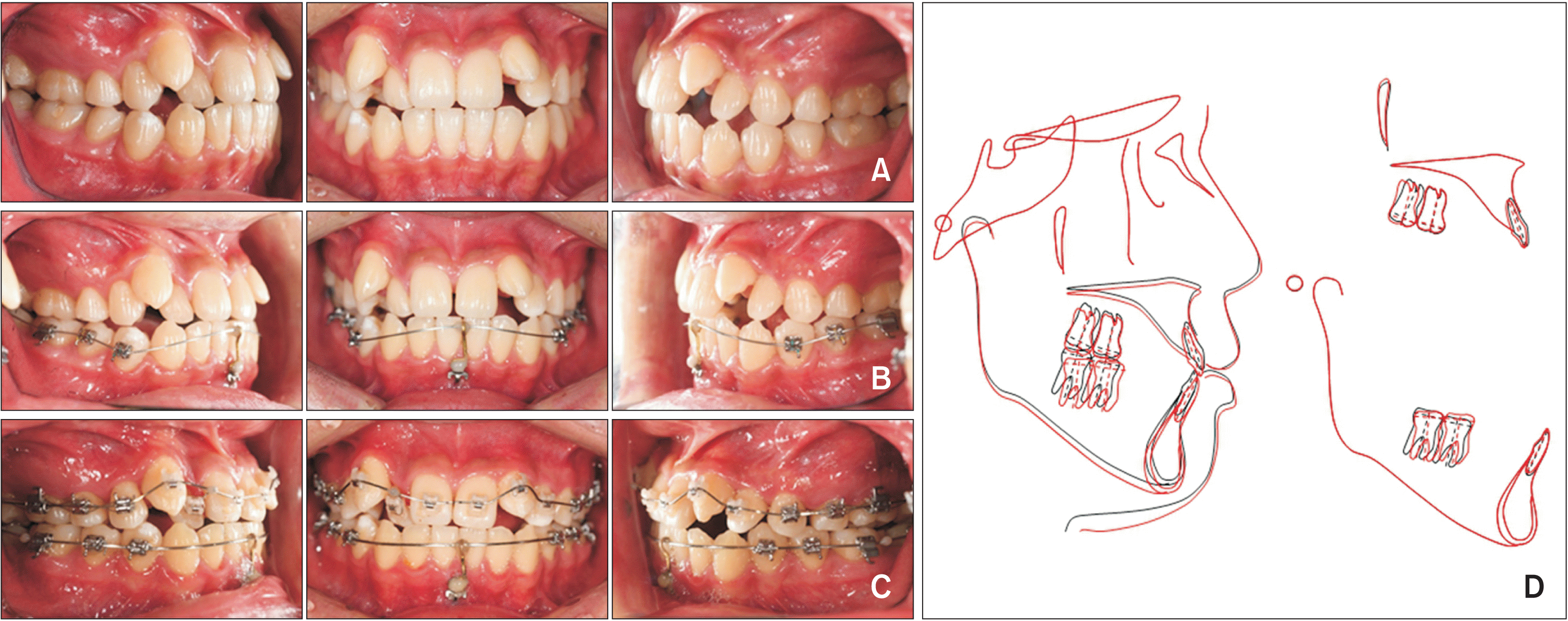
Figure 2
Orientation. A, Reference points in frontal view. B, Reference points in lateral view. C, Coordinate axes.
Rt., right; Lt., left; MF, mental foramen; Go, gonion; Me, menton.
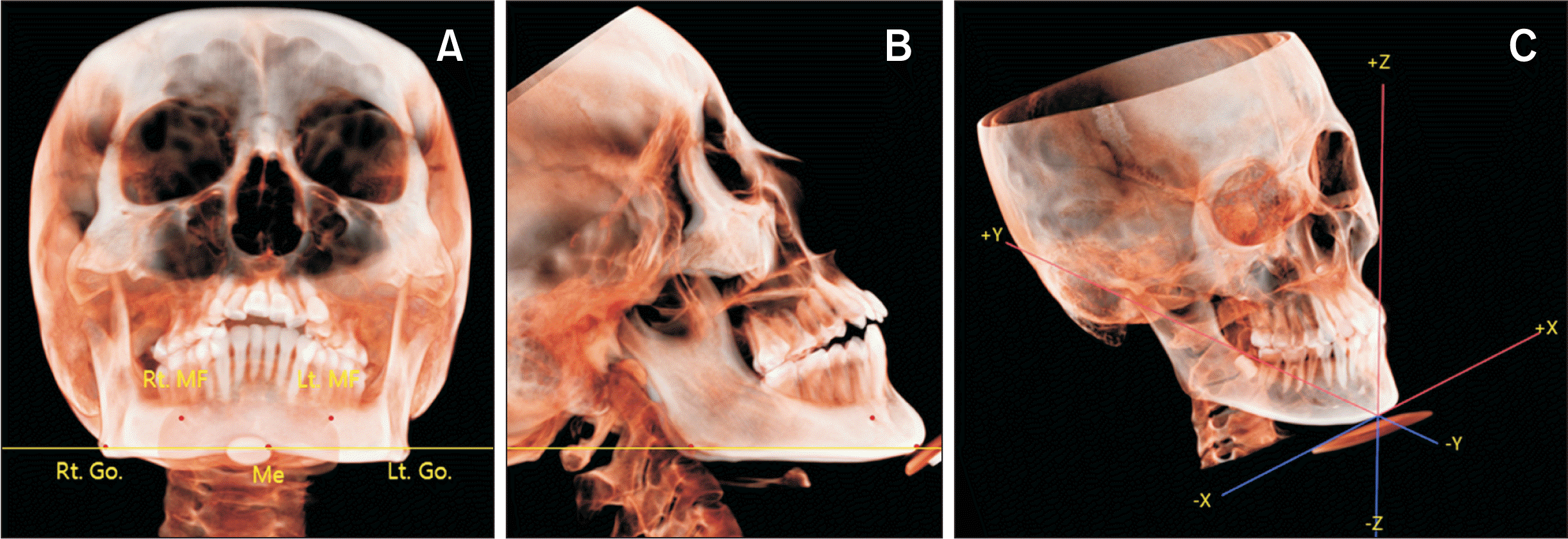
Figure 3
Landmark determination process. A, Landmark determination in the ON3D program (3D ONS Inc., Seoul, Korea) (pre-BRC). B, Landmark determination in the ON3D program (post-BRC). C, Reference point of landmarks.
BRC, biocreative reverse curve.
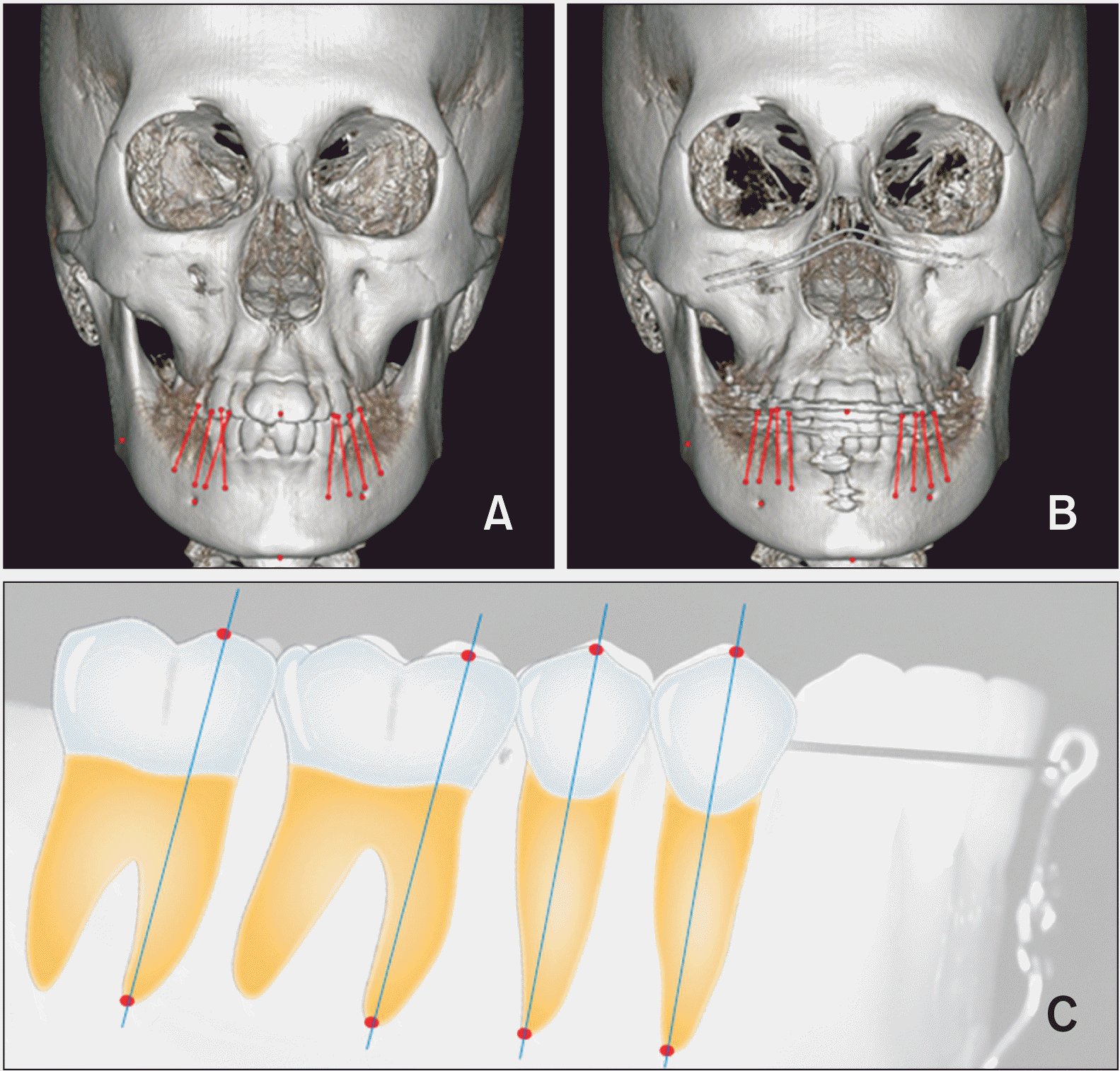
Figure 4
Inclination change. A, Pre-BRC inclination of the mandibular first molar. B, Post-BRC inclination of the mandibular first molar with apparent change in angulation. C, Pre-BRC inclination of the mandibular first molar. D, Post-BRC inclination of the mandibular first molar.
BRC, biocreative reverse curve.
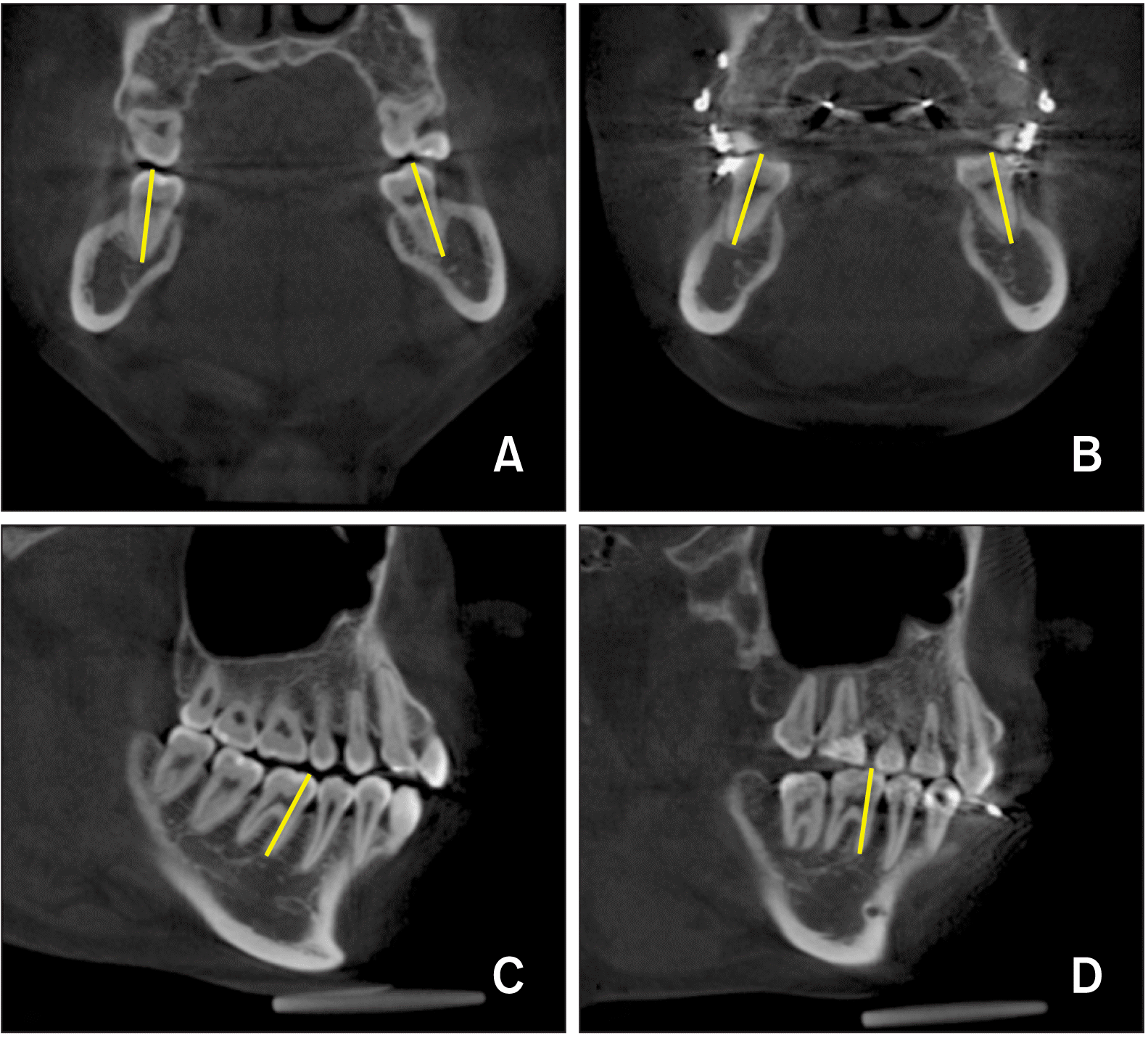
Figure 5
Changes in angulation and inclination before and after biocreative reverse curve system application. A, Angulation change. B, Inclination change.
L4, the mandibular first premolar; L5, the mandibular second premolar; L6, the mandibular first molar; L7, the mandibular second molar; T1, pre-biocreative reverse curve (BRC); T2, post-BRC.
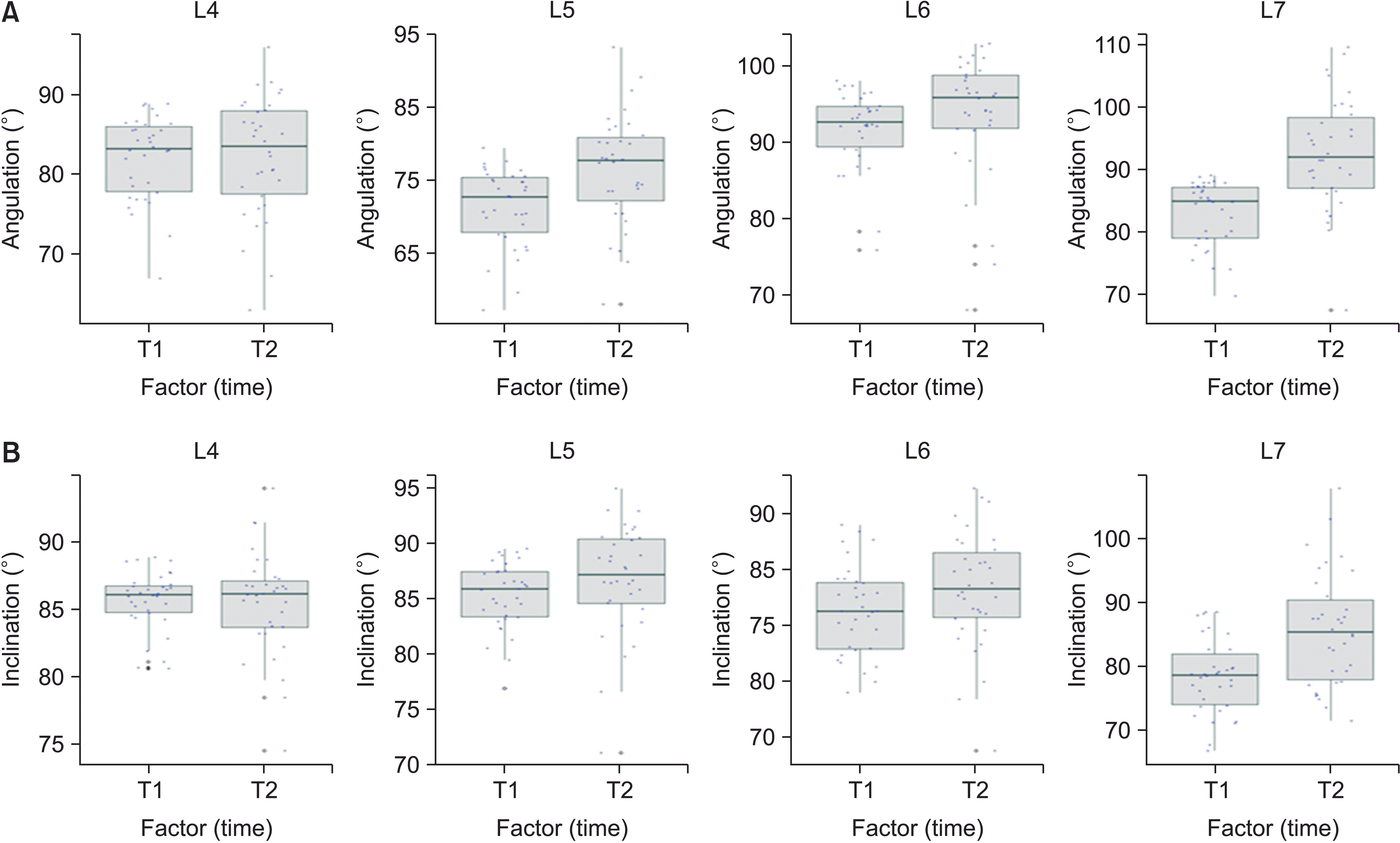
Figure 6
Application of the twisting technique in the biocreative reverse curve (BRC) system. A, Placement of metal stop accessories. B, Archwire twisting and fixation with flowable resin composite. C, Intrusive force by twisting technique. D, Cross-sectional illustration of the twisting BRC technique. E, The biomechanics of the twisting BRC system.

Table 1
Amount of crown and apex movement in x, y, and z-axis directions before and after biocreative reverse curve system application
| Variable | X | Y | Z | ||||||||||||
|---|---|---|---|---|---|---|---|---|---|---|---|---|---|---|---|
| N |
Mean (mm) |
SD (mm) |
p-value* | N |
Mean (mm) |
SD (mm) |
p-value* | N |
Mean (mm) |
SD (mm) |
p-value* | ||||
| Crown | Total | 272 | 0.65 | 0.35 | < 0.0001 | 272 | 0.62 | 0.12 | 0.0498 | 272 | 0.83 | 0.18 | < 0.0001 | ||
| L4 | 68 | 0.12 | 0.57 | 68 | 0.60 | 1.24 | 68 | 1.22 | 1.12 | ||||||
| L5 | 68 | 1.03 | 1.11 | 68 | 0.54 | 1.14 | 68 | 1.64 | 1.09 | ||||||
| L6 | 68 | 0.97 | 0.98 | 68 | 0.68 | 0.99 | 68 | 1.26 | 1.22 | ||||||
| L7 | 68 | 0.49 | 1.41 | 68 | 0.65 | 1.02 | 68 | –0.81 | 0.81 | ||||||
| Apex | Total | 272 | –0.25 | 0.22 | < 0.0001 | 272 | –0.62 | 0.27 | < 0.0001 | 272 | 1.31 | 0.12 | < 0.0001 | ||
| L4 | 68 | 0.17 | 0.42 | 68 | 0.54 | 1.09 | 68 | 1.47 | 1.17 | ||||||
| L5 | 68 | 0.46 | 0.78 | 68 | –0.03 | 1.13 | 68 | 1.98 | 1.06 | ||||||
| L6 | 68 | 0.22 | 0.58 | 68 | –0.85 | 0.96 | 68 | 1.93 | 1.31 | ||||||
| L7 | 68 | –1.86 | 0.93 | 68 | –2.16 | 1.59 | 68 | –0.15 | 1.05 | ||||||
Table 2
Angulation and inclination change before and after biocreative reverse curve system application
| Variable | T1 | T2 | Mean difference | p-value* | p-value† | ||||||||
|---|---|---|---|---|---|---|---|---|---|---|---|---|---|
| N | Mean | SD | IQR | N | Mean | SD | IQR | ||||||
| Angulation (°) | Total | 272 | 82.12 | 5.17 | 7.29 | 272 | 86.25 | 8.84 | 9.33 | < 0.0001 | < 0.0001 | ||
| L4 | 68 | 81.99 | 5.23 | 8.52 | 68 | 82.18 | 7.41 | 10.72 | 0.19 | 0.0490 | 0.0417 | ||
| L5 | 68 | 82.00 | 5.26 | 5.94 | 68 | 83.83 | 8.45 | 7.35 | 1.83 | 0.0079 | 0.0328 | ||
| L6 | 68 | 81.49 | 5.14 | 7.59 | 68 | 86.45 | 7.17 | 8.87 | 4.96 | 0.0604 | 0.0328 | ||
| L7 | 68 | 83.00 | 5.15 | 8.29 | 68 | 92.54 | 8.85 | 8.75 | 9.54 | 0.0026 | 0.0370 | ||
| Inclination (°) | Total | 272 | 82.64 | 4.95 | 6.92 | 272 | 85.27 | 6.10 | 7.08 | 0.0159 | 0.0617 | ||
| L4 | 68 | 85.60 | 2.18 | 2.07 | 68 | 85.46 | 3.78 | 3.54 | –0.15 | 0.0021 | 0.1344 | ||
| L5 | 68 | 85.24 | 3.01 | 4.12 | 68 | 86.76 | 4.96 | 5.89 | 1.52 | 0.0052 | 0.0393 | ||
| L6 | 68 | 81.31 | 3.98 | 6.01 | 68 | 83.20 | 5.18 | 6.20 | 1.89 | 0.1349 | 0.5234 | ||
| L7 | 68 | 78.41 | 5.86 | 11.63 | 68 | 85.67 | 8.92 | 13.45 | 7.26 | 0.0183 | 0.2913 | ||




 PDF
PDF Citation
Citation Print
Print



 XML Download
XML Download